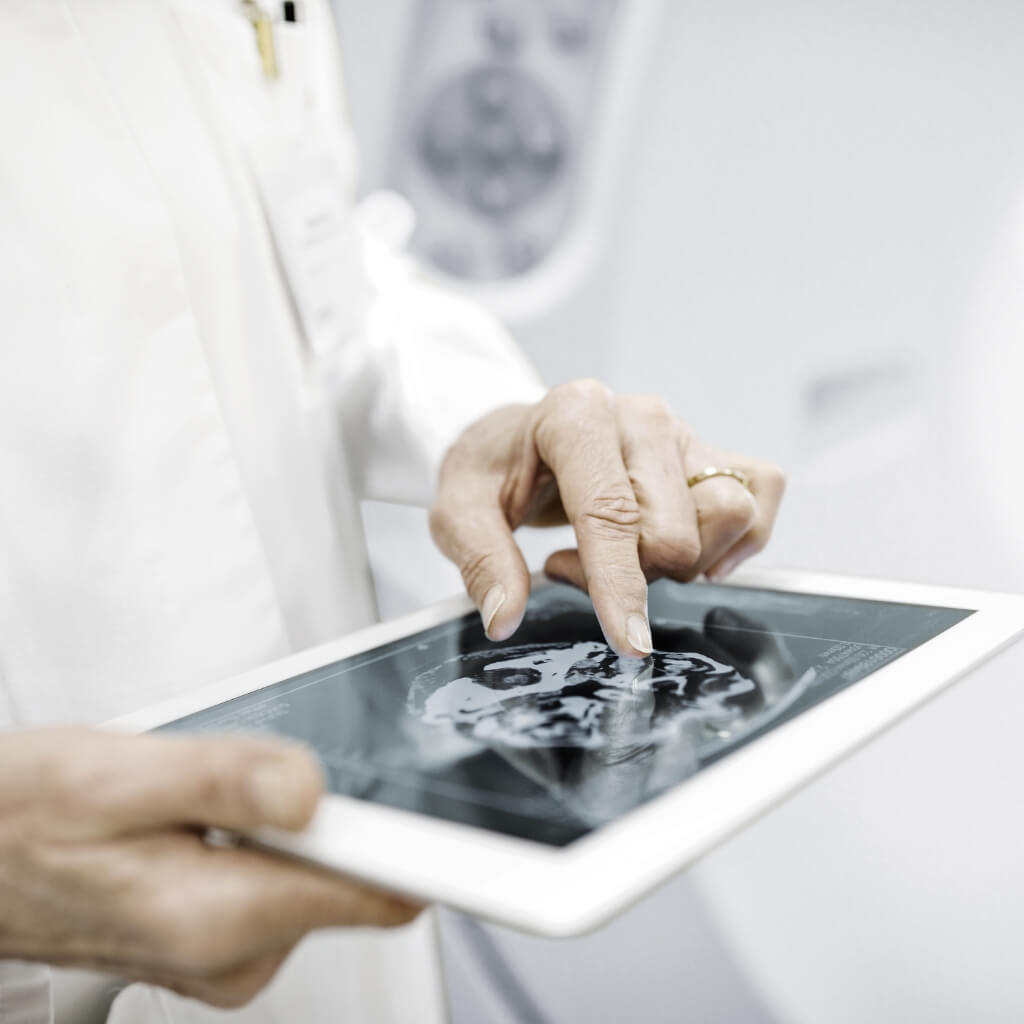Chimeric Antigen Receptor T Cell Therapy (CAR-T): Genetically programmed immune cell binds to and destroys cancer cell / Therapy is now available for the majority of indications
23. September 2022 • Robotics
23. September 2022 • Robotics
Addition of innovative hybrid systems to the Surgical Center’s central operating room now complete
Patient care improved by integrated high-end imaging and navigation
The extension of the central operating theater at Leipzig University Hospital was formally opened on September 6, 2022. Three additional operating rooms with intraoperative imaging are now available for treatment. And because they’re equipped with the latest navigation equipment and other instruments such as integrated CT, MRI and angiography systems, they take high-precision surgery to the next level. Leipzig University Hospital now has the most advanced operating rooms in central Germany.
This marks the culmination of two and a half years of building work and conversion – with surgery continuing uninterrupted the whole time. During this time, a brand-new wing was built on top of the Vascular Medicine Center (completed in 2017) with 1,000 square meters of floor space, augmenting the existing 12 central operating rooms at Leipzig University Hospital. The centerpiece comprises three ultramodern operating rooms with innovative hybrid equipment allowing the use of imaging systems during surgery in conjunction with navigation techniques. This forms the basis for computer-assisted high-precision surgery of the highest order.
A 3-Tesla magnetic resonance imaging (MRI) scanner along with a radiology workstation have been installed in one of the new ORs. Directly connecting the OR to the MRI allows control examinations to be carried out during an operation to check whether a tumor has been completely detected – a decisive factor for the patient’s survival. Important structures can be better protected while diseased tissue is safely removed, something which is especially important in neurosurgery for brain tumors.
In the second new OR, a mobile computed tomography (CT) scanner and a 3D C-arm can be used to perform complicated operations on the spine, pelvis or any joints with intraoperative image control. The CT data flows directly to the integrated navigation system for computer-aided planning to ensure the correct placement of implants, which is decisive for their long-term stability and to protect important anatomical structures.
In the third hybrid OR, angiology and vascular surgery specialists benefit from a state-of-the-art low-dose radiation angiography system with all necessary accessories such as a wireless ultrasound device. This system is used primarily in complicated operations on the aorta and other large blood vessels for the treatment of aneurysms and shows the exact course and condition of the vessels to be operated on. This also opens up new possibilities in the care of accident victims and emergencies, thanks in part to the direct connection of all the central ORs at Leipzig University Hospital to the emergency room and intensive care units.
“These three hybrid operating rooms herald a new era of high-end surgery for us,” said Professor Christoph Josten, Medical Director of Leipzig University Hospital, at the opening ceremony. “With the help of the new equipment and software, we can perform extremely complex procedures with high precision and maximum safety for our patients, largely avoid complications, and ultimately save lives,” he explained. “It’s all thanks to the government of Saxony, which provided funding of over €30 million for construction and equipment,” added Dr. Robert Jacob, Commercial Director of Leipzig University Hospital.
Minister of Science Sebastian Gemkow also attended the opening ceremony and saw that this was money well spent. “Leipzig University Hospital’s expertise in the surgical treatment of complex cases has been continually increased for many years, especially in the area of emergency medicine,” he said. “The state-of-the-art ORs boost this proficiency and further improve care for patients from the entire region. I’m delighted to be able to attend the opening ceremony today for this center of high-performance surgery.”
Construction without interrupting everyday surgery
To connect the new operating theaters to Leipzig University Hospital’s 12-room OR wing, three connecting bridges were built that are directly connected to existing OR sterile corridors. In addition, the extension of the holding area (anesthesia and recovery room) and ancillary operating room areas created larger sterile storage rooms, improved personnel locks, a comfortable recreation room, and new office space for the operating room staff at Leipzig University Hospital. In addition to the pandemic, they also had to cope with the conversion carried out in recent years. After all, the existing ORs continued to be used, and had to be separated from the construction site by protective measures such as dust protection walls – a major challenge in a sterile area where work was only interrupted for a short while by moving operations within the hospital. Many individual areas of the ORs had to be moved several times.
In order to connect the extension to the existing part of the building, sophisticated work was necessary involving complex drilling and caulking work on the existing structure. “All these measures demanded a high degree of flexibility and hard work from the staff,” said Dr. Robert Jacob. He added: “We’d like to take this opportunity to express our sincere thanks to all our employees, and apologize to our patients and partners for the stress and strain associated with the construction work the over the past few years.”
First operations on September 5
The first operations in the new ORs were carried out on September 5 by vascular surgeons together with angiologists using the new angiography system. Aneurysms (bulges) of the aorta in two patients aged 66 and 82 were treated with stent grafts. In these minimally invasive, life-saving operations, individually adapted vascular endoprostheses were painlessly inserted.

cell-immune-gene-therapies
Small glas bottle which is normally used to store vaccine
Chimeric Antigen Receptor T Cell Therapy (CAR-T): Genetically programmed immune cell binds to and destroys cancer cell / Therapy is now available for the majority of indications

digital-health
Human who looks onto a recording of brainwaves on his tablet computer and moves the model with his fingers
The Smart Infrastructure Hub Leipzig will receive a further 1,9 million euros from the cluster funding of the Saxon Ministry of Economic Affairs.

cell-immune-gene-therapies
Small glas bottle which is normally used to store vaccine
A relatively small metropolis in Germany’s Free State of Saxony – a dynamic hub for the life science industry? What was just a vision 20 years ago has become a reality for the city of Leipzig, which from October 24-26 co-hosted BIO-Europe, Europe’s largest annual biotech partnering event.

services
Woman who looks at something through a microscope while another woman ist watching her
The European Commission has approved the Saxon ERDF/JTF program for the funding period 2021 to 2027.